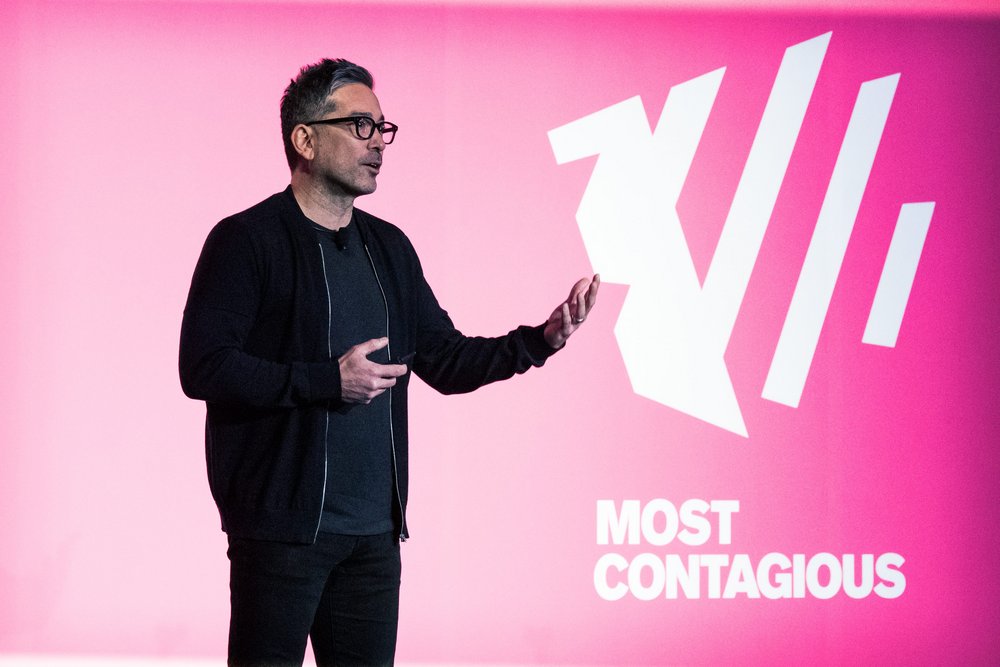Promoted content
Creativity for humanity /
Data is an essential part of our everyday lives, but is our obsession with analytics killing our creative souls? At Most Contagious in New York, Ray Page, executive vice president of digital & experience technology at WE Communications, a Contagious thought-leader partner, argued for more collaboration between data and creativity, and explained why we need to future-proof our creative team structures.

‘Let’s be honest,’ said WE Communication’s Ray Page at Most Contagious this week. ‘Data and technology – when it’s not working together with creative, it’s at the cost of creative.’
The best campaigns, he explained, are those that use data and tech but are fuelled by human emotion and creative ideas.
What we’re all striving for, argued Page, is brand voice (‘the way a brand communicates today couldn’t be more important… even the way a CEO behaves goes into the way we perceive brands today’), digital expression and tech for behavioural change.
When all three of these things are done right, said Page, it inspires belief and action. And none of it is possible without data and technology.
Ray Page, WE Communications
‘Tech is for everyone, it’s part of our fabric, it’s part of our DNA,’ added Page.
There is 11% growth each year in investment in consumer-facing tech – from $483 billion in 2017 to $539 billion in 2018.
And while investment in tech is on the increase, investment in creativity and creative agencies is in decline.
Page used customer experience (CX) as an example. Booking, banking and the way we buy things online are all largely the same, no matter what website or app you use.
‘We’re all solving the same problems, using the same people and partners, building off the same technology platforms and designing for the same two screens,’ he said.
Ray Page, WE Communications
But what happens when you mix utility with something more powerful? More human? ‘When we infuse technology with creativity and emotion […] we can create behavioural change and, most importantly, loyalty,’ Page explained.
The examples he pointed to included a spot from Nike’s 2012 ‘Find Your Greatness’ campaign: ‘an amazing, emotionally fuelled idea that [Nike] laid on top of a utility [the Nike Run Club app]. Which is still to this day the most downloaded running app on the App Store.’
Part of the app’s success, said Page, was its social function – the ability to collect badges, to share your achievements and goals on social media, to belong to a bigger community of Nike Run Club runners.
In 2016, when Nike removed these components of the app, the Internet was outraged – ‘that was their emotional connection with this utility,’ explained Page.
Nike has slowly been reintroducing those features, but Page’s point is that no matter how strong your utility is, people need to be able to connect with it on an emotional level.
He also pointed to Black & Abroad’s use of emotion and creativity in line with data in its Go back to Africa campaign, which won the Grand Prix in the Creative Data category last year at Cannes.
Bill Bernbach, DDB
‘The goal is to create these emotion-fuelled experiences in technology,’ said Page. And to do so, we need the right team. Page quotes DDB’s Bill Bernbach: ‘An idea can turn to magic or dust depending on the talent that rubs against it.’
What does today’s ideal team look like? You need a trifecta of different talent, according to Page.
A creative who understands ‘high-level big ideas’ and can code. It used to be a rarity – not anymore, Page said. Then you need a coder, a prototyper, a front-end builder. ‘Those two are imperative.’ Finally add a social strategist into the mix, someone who understands different platforms, audiences and ‘how to make ideas fly’.
If you change one of those roles it changes the entire output. It’s about building a way of working that is future-proof, Page explained.
He ended with three practical ways in which to ensure a synergy between technology and creative: invest in creative and infuse creative teams with tech people, combine unassuming objects to create new offerings and ‘determine your product and push it upstream’ (be mindful of business objectives and bring those to the fore).
Learn more about Ray’s proposed model to optimize creative tasks of the future.
Want more of the same? /
We don’t just write about best-in-class campaigns, interviews and trends. Our Members also receive access to briefings, online training, webinars, live events and much more.




